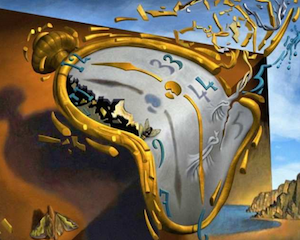
How modernist architects like to think of themselves. Meet George Jetson! (Hollywood Reporter)
Occasionally I am urged to stop using “modern architecture” and use “modernist architecture” instead. The complaint, which issues from some of architecture’s top thinkers and makes considerable sense, is that the word modern normally means “of today” or “up to date,” and that “modernist” serves to identify it as a tainted “ism” – an ideological term not to be confused with the plain everyday meaning of the word.
Calder Loth, a former preservationist for the Commonwealth of Virginia, points out that “Modern is no longer modern. It should not be called modern because it isn’t anymore. It’s been around for 100 years.”
Léon Krier, a leading theorist on architecture and urbanism, told an interviewer: “[T]he now commonly used expression Modern Movement needs to be corrected to Modernist Movement. I keep repeating this because modernist propaganda dominates via the fraudulent appropriation of the term ‘modern,’ claiming that theirs is the only legitimate form of modernity in art and architecture.”

“Melting Watch” (1954), by Salvador Dali. (dalipaintings.com)
I get the point. But for all practical purposes it seems six of one and half a dozen of the other. Adding “ist” isn’t going to change how readers interpret either phrase. The goal is not so much accuracy as rhetorical effectiveness. With or without “ist,” the root word modern remains, doing the propaganda job assigned to it by the founders of the Modern Movement. Too bad, but mission accomplished.
(By the way, if I may be permitted a point in my own defense, I always use the word modernist unless it is directly in front of the word architecture.)
More interesting might be to try to find another word to substitute for either modern and modernist. Recently, in a discussion among trads, several words were suggested as options, some of them, I assume, jokingly. They included “Modernesque,” which has the same problem as modernist. From another source came several problematic stumpers: “Styless” (accurate, possibly misspelled, and unintentionally in sync with the declaration that modern architecture is not a style); “Nonpulcher” (derived from the Latin words for not and beautiful and, while accurate, too abstruse); “Vapidus” (meaning flat or insipid, also too abstruse); and “Solumutilis” (in Latin solum means soil, so, perhaps, rich soil for buildings? That can’t be it. Its common usage is preceded by a negative, so “Nonsolumutilis” makes more sense. Help!).
The founder of the classical revival, the late Henry Hope Reed, preferred “Anorexic” as a more descriptive term for modern architecture. Quite right. Still, that may also be a bit on the abstruse side, and modernists might object to being equated with an adolescent eating disorder. Maybe “Abstract” would be preferable, if it matters what modernists feel. Call it abstract architecture. This might stroke the modernist amour-propre. Modernists might find that acceptable, just as they seem so shockingly unperturbed by our use of the words traditional and classical architecture.
***
[Note: Between Jan. 31 and Feb. 11, the survey results from the poll on classical versus modernist architecture have swung from No (the modernists) leading 92-8 percent to Yes (the classicists) leading 64-36 percent. Please vote. The deadline Feb. 26.]



Pingback: Hawthorne on architecture | Architecture Here and There
“Solum utilis” means “only useful” which apparently points to the fact that modernist architecture doesn’t allow anything non-useful (to a modernist) such as a cornice.
I personally suggest Inhuman, Dystopian and Autistic.
LikeLike
Also “Vandalist architecture” has a nice ring to it. Modern buildings inevitably attract vandals, but it’s only because they were “built by vandals, and those that added the graffiti merely finished the job,” as Sir Roger Scruton put it.
LikeLike
I will keep it at ‘brutalist’, it matches the style and attitude. Pretentious hyper-reflexivity (or just bullshit?) is the mental glamour often attached in order to legitimize both modern art and the secular symbols of power of brutalist architecture. Which is why corporations love it. It is also connected to worship of technology (futurism,transhumanism), behind the glamour of the technology, behind the pretence lurks a primitive barbarism though.
LikeLike
Call it what it is… your choice; Anti-Classical, Anti-Traditional, Anti-Cultural
LikeLike
Not sure if you will gut this, but you used the word yourself. How about “perturbed” architecture, or perturbitecture?
Sent from my iPhone
>
LikeLike
Tony, I like that. But you have a master’s degree in rhetoric, so I’m sure you can see that in a debate, using the same language that both sides agree on is more important than using language that is precisely correct according to the different perceptions of either side. If we started calling new classical architecture “modern architecture” because it was built recently, the confusion would be such that the argument could not effectively proceed. Bystanding listeners not involved in the argument would be totally baffled. Imagine if the modernists demanded that their architecture be called “traditional architecture” because it is a century old. Total confusion. Sometimes you have to recognize when the other side has trumped you rhetorically and move on. Sure, go ahead and use “modernist,” but recognize that the meanings are the same. Like it or not, no one is going to mistake the meaning of “modern architecture” because the suffix “ist” is not attached.
LikeLike